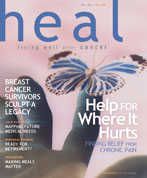Publication
Article
Heal
Book Review
Author(s):
Book review of "Here's the Bright Side"
As one of the first women to talk about her breast cancer experience, Betty Rollin became a heroine to many survivors with the publication of her 1976 book, First, You Cry. Two years later, she became a heroine to the broader public as well: Many people wept as they watched the TV movie version of the book starring the very popular Mary Tyler Moore.
With her new book, Here’s the Bright Side (Of Failure, Fear, Cancer, Divorce, and Other Bum Raps), Rollin looks at what happens to those who experience events such as cancer when looking back from the perspective of a long-term survivor. She explains what many of us have felt and now is beginning to be revealed in psychological studies: If we do the head and heart work of cancer, we can choose to find the gifts in our diagnosis and emerge a better, stronger, more insightful and joyful person. For those newly out of treatment reading this pronouncement, stay calm, because, as Rollin also points out, just like any transformation, experiencing the positives takes time and perspective. And for many people it’s a choice — whether they will look at the storm cloud or the silver lining.
Rollin explains the studies that have confirmed people do report positives from adversity — a reaction labeled paradoxical growth. In other words, how can something as difficult and painful as cancer have a positive side? Or, as one therapist describes it, “another darned growth opportunity.” But it does, and the studies now prove it. Indeed, Rollin quotes the studies that were designed to show how horrible the experience has been for survivors — only to find that the subjects interviewed disagreed. They had become more resilient, more sure of themselves and now saw cancer as a turning point in their lives.
Cancer — or any life crisis, Rollin points out — gives us a new life vision that moves us from living in the future “when we have …” or “when the money is there,” to treasuring the small moments of joy and love that occur every day. Trauma slows us down so that we can actually experience those treasured moments of life instead of just looking at them in photo albums. It brings us to our knees where we can see the bright, joyful colors of a day and be grateful we have been allowed this moment.
Rollin gives many examples of people in the headlines who grew through destructive moments to be brighter and better, realizing that the negative was a catalyst for self-understanding and self-actualization.
Does Rollin’s approach require optimism? Maybe, but more than that she is saying, “Listen, this has been a rotten experience, but what you decide to do with it is in your lap. You can be angry and bitter” — as many people have the right to be who don’t have the resources to thrive with a cancer diagnosis.
But you can also search for the kernel of positive that has come from cancer: meeting the person at the doctor’s office who has become the kind of friend you have never had, getting to blame chemo for everything, laughing at storms because they used to scare you.
If you wake each day engaged in gratitude, Rollin says, it will be impossible to stay gloomy. When you see others facing cancer with courage and hope, ask yourself how many times in a lifetime anyone gets to see what real courage looks like, when it is visible and physical and standing in front of you.
We have a choice to grow from every experience we have — if we open our eyes and see how the negative can grow the positive.
We have a choice to grow from every experience we have — if we open our eyes and see how the negative can grow the positive.






